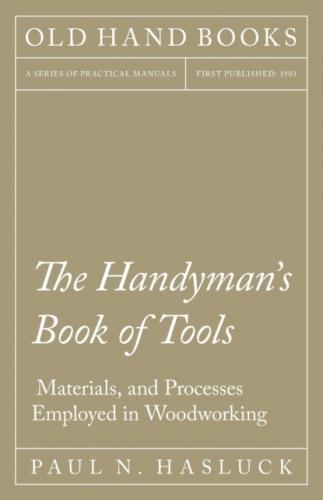Fig. 461.—Nailing together a Box.
Fig. 462.—Incorrect Nailing.
Fig. 463.—Side View of Correct Nailing.
Fig. 464.—Careless Nailing.
Fig. 465.—Bradawls and Nails in Wood.
Fig. 466.—Clinched Nails.
Fig. 467.—Square Nail Set or Punch.
Fig. 468.—Round Nail Set or Punch.
Fig. 469.—Using Nail Set or Punch.
WITHDRAWING NAILS.
Should the nail, in spite of all care, split the stuff or turn out at the side, it should be carefully withdrawn before the head has been driven too low, or withdrawal becomes difficult. To draw the nail, its head is carefully and tightly grasped with the pincers, as in Fig. 470, and the ends of the handle are then pressed down towards the face of the work; few nails can resist the force of this leverage. Should the nail be of the cut variety, care must be exercised, or it may break off. A piece of wood should be laid under the pincers as shown, or they may bruise the work.
SECRET NAILING.
Sometimes, after a piece of work is finished, some of the joints will spring, and it will be necessary to secure them from the surface with nails. In a general way, the heads of these are punched in, and the holes stopped with beeswax and shellac coloured to match the wood; or, in the case of painted wood, putty would be used as a filling. The stopping may be carefully put in and cleaned off, but it can always be detected if the work is closely examined. The method of nailing shown in Fig. 471 has the advantage of perfectly concealing the nail head. An outside mitred corner is shown for the purpose of illustrating the method of nailing. A chip is raised by means of a narrow chisel or gouge, a hole bored underneath the chip, and the brad driven and punched in. The chip is then glued down over the head of the brad, and, when dry, is cleaned off. It will be readily seen that, as the chip is of the same colour and grain as the piece from which it was raised, the hole will not be visible. This method of nailing would apply equally well to a planted bead or moulding, or to any other purpose that may be required.
CLEANING RUSTY NAILS AND SCKEWS.
The best way of brightening a quantity of nails that are very rusty is to dip the nails in oil and put them in a bag with emery powder; by rapid friction some of the rust may be removed. Such articles should be kept in a dry place, when they would not rust. A tumbling drum often is used for cleaning rusty nails, etc. The apparatus consists of a barrel, with a door in it, which runs eccentrically on a spindle, the spindle being driven either by hand or steam. Into the drum are placed river sand, moistened with dilute sulphuric acid, and then the articles to be cleaned. When the drum is revolved the articles are continuously shifted, so that every part is polished. Screws that are too small for separate treatment may be cleaned as follows: Take, say, one pound of screws, and place them in a small box, such as a cigar box. Put a small quantity of oil on them and shake for a minute; then put a piece of cotton waste in the box, and repeat for a minute; finally put a handful of sawdust in the box and shake for another minute or so, and remove the sawdust by sifting it from the screws in a fine sieve. This treatment will be found effective. Larger quantities are apt to be ruined by being shaken together, the sharp corners, threads, and points rapidly disappearing.
Fig. 470.—Withdrawing Nail with Pincers.
HISTORY OF WOOD SCREWS.
The screw nail used for uniting woodwork is known as the “wood screw”. This combines several of the most important principles of science and mechanics. As a mechanical power its basis is the inclined plane. Previous to the opening of the nineteenth century, iron, brass, and steel screws were but rarely used. During 1813, Penniman, in America, perfected machinery for drawing wire suitable for screws of all kinds. During 1817, Dow and Treadwell, of Boston, made other improvements; their machine drew the wire from the reel, cut it to the length required for each screw, headed the screw, cut the thread, and polished the screw. Meanwhile English manufacturers were also making improvements in the quality and finish of screws for woodwork, until these screws obtained, on both sides of the Atlantic, the commercial name of “wood screws,” to distinguish them from those used to put together and operate machinery. But the wood screw had one obvious defect. The worker was compelled to use a bradawl, gimlet, brace and bits, or some similar implement to make a fairly large hole to give the screw an entrance, and this operation occupied so much time that many workmen chose well-finished nails in preference to screws. During 1841, however. Thomas J. Sloan invented the now familiar “gimlet point” wood screw, which, under the pressure of a good screwdriver in a workman’s hand, entered any kind of wood as readily and with no more danger of splitting the wood than the entrance of a carefully
